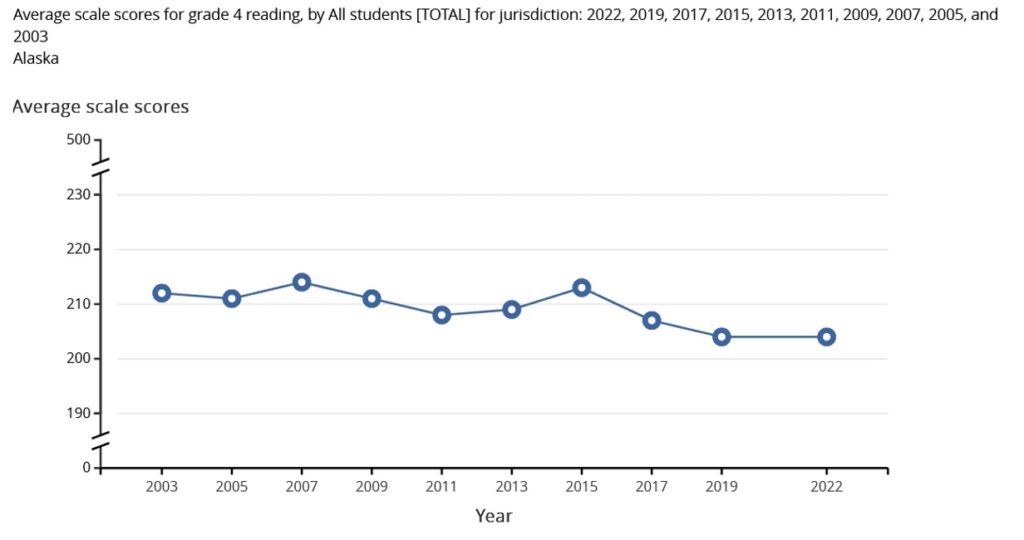
Miniature graduation cap on dollars bills. Student debt crisis.
By David Boyle
Commissioner Deena Bishop of the Department of Education and Early Development briefed the House Education Committee that Alaska will spend $2,696,944,300 on K-12 education in the current school year.
This was an eye-opening and startling factual presentation, unlike the “Raise the BSA” chants from the education industry that echo through the Capitol.
The revenue comes from four sources: State of Alaska, local taxes, federal taxes, and district unreserved fund balances. A much smaller amount of $73 million comes from private grants.
Here is the department’s pie chart showing the various percentages and total dollars from each revenue source:

Remember to add 3 zeroes to all the above numbers because the chart shows dollars in thousands.
Besides the total spending on Alaska K-12, the federal taxpayers send $363,141,300 to Alaska. Because of this, the federal government has control over our K12 education system. It can influence policy by threatening to withhold funds.
The federal government provides funding through 23 grant programs. Here are the major grants:
- $68.8 million to Title 1, Part A for Title I, Part A for improving basic programs operated by local school districts
- $28.9 million for Title I, Part C Education of Migratory Children
- $458 thousand for Title 1, Improving Education for the Disadvantaged & Struggling Students
- $14.3 million for Title II, Part A, Preparing, Training and Recruiting High-Quality Teachers, Principals, and Other School Leaders
- $2.1 Million for Title III, Part A Language Instruction for English Language Learners, and Immigrant Students
- $310 thousand for Migrant Literacy
- $5.9 million for Title IV, Part B 21st Century Community Learning Centers
- $15.1 million for Comprehensive Literacy State Development
- $27.6 million for school lunch programs
Many in the education industry complain that the Alaska Reads Act is not funded enough. But notice that the federal government provides $15.1 million (item 8) for improving literacy. The State kicks in another $3 million to implement the Alaska Reads Act.
Where does all this literacy funding go? Does it go to the classroom? Is it making a difference in teaching our kids how to read? Or is this literacy funding fungible so it can be used for almost anything?
The federal government also kicks in $68.8 million for Title 1 schools (lower income) for “improving basic programs” which should include teaching reading and math. Yet still our kids are not learning to read and do basic math. Here are the latest NAEP (National Assessment of Educational Progress) and AKSTAR (Alaska System of Academic Readiness) statewide results:

The above percentages show that almost 3/4ths of our 4th grade students are not reading at grade level despite the more than $18 million specifically earmarked for literacy. Nearly 88% of our 8th grade students are not literate in basic math skills. The NAEP rankings compare Alaska students to the 50 states and the District of Columbia.
And there’s also the Covid-19 money the federal government has thrown at Alaska’s K-12 education system: An astounding $219,356,262.
What was the $219.3 million used for? Many school districts used this one-time Covid-19 money to pay salaries.
Let’s look at the State of Alaska funding for K-12 education. The State of Alaska spends more than $1.337 million on K12. Here are the major funding sources:
- $70,840,000 for pupil transportation
- $4,127,100 for “Quality Schools”
- $87,443,000 for one-time funding from legislature
- $1,150,514,500 for the Base Student Allocation
The education industry wants to increase the pupil transportation by another $209 per student. Note that not all students are transported by school districts. For example, the Anchorage School District does not transport its own charter school students even though it gets state funding for that purpose. ASD only transports about 14,000 students, but it receives funding to transport all 43,000 students.
Finally, there are local revenues that jack up the K-12 spending. Here are the sources of the local revenue:
- $530,070,400 from local city/borough appropriation (usually property taxes)
- $20,292,200 from in-kind services
- $95,493,000 from E-Rate funding (more on this below)
- $129,143,800 from more federal revenue
The E-Rate program is funded by all cell phone and landline customers. Look at your bill for the Universal Services Fund tax. The program is used by schools and libraries to fund broadband and other communications services.
The $95 million is a significant amount that most people are unaware they pay for, because it is a hidden tax on cell phones and landlines. It’s another tax by the federal government that sends your dollars to K-12 schools.
The “federal revenue” in item 4 is mostly federal impact funds that districts receive from the federal government for nontaxable federal property, such as JBER.
How much does all this funding equate to per student?
The projected number of students for this school year is 128,579 — statewide. But one must subtract the number of correspondence students out of the total funding because they only get 90% of the BSA — $5,364. There are 20,900 correspondence students. They cost $112,107,600.
Subtracting the $112,107,600 from the $2,696,944,300, leaves $2,584,836,700 for the remaining 109,100 students.
Thus, the per student cost for Alaska is $23,692. If there are 25 students in a classroom, the total cost for that classroom is $592,300, surely more than enough to teach a child how to read.
The education industry wants to raise the BSA by a massive $1,413 which increases the K-12 funding by $362.9 million. That equates to 276,600 Permanent Fund dividends, valued at last year’s PFD amount.
All the education industry members, local school districts, NEA (teachers union), Alaska Council of School Administrators, Alaska Association of School Boards, and the Coalition for Education Equity want to increase the BSA.
But what they don’t want is accountability for the spending of the funds.
So, the education industry folks chant, “Raise the BSA” in hopes of getting more money from the Legislature.
Meanwhile, student achievement has “flat-lined” since 2002. Here are the NAEP 4th grade reading scores from 2003 through 2022:

More money will not improve student outcomes. It will grow the K-12 bureaucracy and incentivize spending even more during an election year.
To hear Commissioner Deena Bishop’s presentation click on this link.
To view the PowerPoint of Dr. Bishop, click on this link.
Do you believe the State should increase the K-12 funding or should school districts manage their budgets better?
You can add your 2 cents worth by sending your comments to the House Rules Committee (House.Rules@akleg.gov) and specify SB 140.



![Body temperature check, prevent virus Concepts in preventing contagious diseases. Corona virus [Covid-19] . social distancing concept.Operator Check Fever by Digital Thermometer Visitor](https://ak4pf.org/wp-content/uploads/2025/03/business-woman-covid-19-2024-10-18-05-28-48-utc-150x150.jpg)





![Body temperature check, prevent virus Concepts in preventing contagious diseases. Corona virus [Covid-19] . social distancing concept.Operator Check Fever by Digital Thermometer Visitor](https://ak4pf.org/wp-content/uploads/2025/03/business-woman-covid-19-2024-10-18-05-28-48-utc-300x196.jpg)


